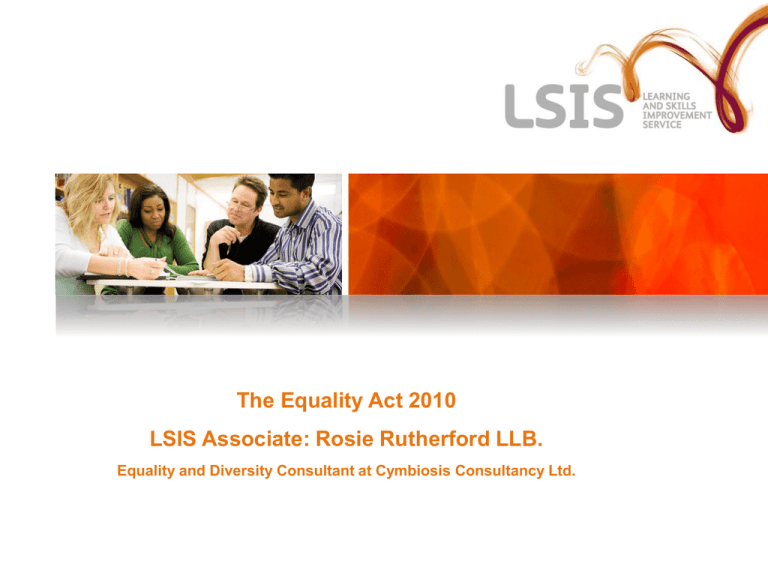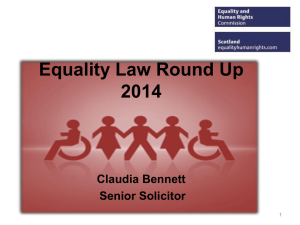
The Equality Act 2010
LSIS Associate: Rosie Rutherford LLB.
Equality and Diversity Consultant at Cymbiosis Consultancy Ltd.
Aims
•
•
Update on the Equality Act 2010
- getting to grips with the changes.
Understand
- liabilities and responsibilities as an
employer,
- liabilities and responsibilities as an
educational provider.
Outcomes – thinking strategically
•
Develop an understanding on how the legal
responsibilities of your organisation in relation to
diversity and equality, inform your expected roles,
responsibilities and performance.
• Develop an understanding on what you need to do to
support your organisation maintaining and continuing to
develop its performance, in relation to mainstreaming
equality and diversity – to create and demonstrate a
change in positive outcomes.
A quick question…. For quick discussion
Why is diversity and equality important to you and your
organisation?
The prejudices of good people:
BMJ 2004;328:1448-1449 (19 June),
If it is only bad people who are prejudiced, that would
not have such a strong effect. Most people would not
wish to imitate them and so, such prejudices would
not have much effect—except in exceptional times. It
is the prejudices of good people that are so
dangerous.”
Vikram Seth. A suitable boy. London: Phoenix, 1993.
Why is diversity and equality important?
Ethical/social justice case
Legal case
Business case
Business case example…..
“Skills shortages, an ageing workforce profile and a decline
in the overall number of school leavers are all key drivers
behind the need to create a more diverse workforce
within our sector. It also makes sound business sense to
have a workforce that reflects its customer base
including women and ethnic minorities.”
Kevin Dowd, Operations Manager, SummitSkills – Building
and Construction.
The public sector equality duty
SECTION 149 OF THE EQUALITY ACT 2010
Cymbiosis Consultancy
Ltd
Pre 2000, historically an individual
model of discrimination had existed
Individual complaints
Tribunals
Statutory grievance procedures
Reality – it is difficult to pursue individual complaints
Cymbiosis Consultancy
Ltd
What changed things
The determination of parents of a young black man
stabbed to death in London, April 1993 to maintain their
son’s reputation and demonstrate the failure of the public
service of the police to protect and support all people in
London, irrespective of their race or ethnicity.
The Macpherson Inquiry report`:
Institutional racism
Stereotyping – impact of bias on thinking, behaviour and
actions
Colour and cultural blindness
Failure to implement policy
Lack of sustained leadership
Cymbiosis Consultancy
Ltd
Report highlighted
•
•
•
Loss of faith in the system among some communities
The need for public services to rebuild trust
The need for public services to demonstrate fairness
Cymbiosis Consultancy
Ltd
Government response
•
•
•
A commitment to remove the potential for
discrimination from the main public services
New legislation in 2000 introduced the concept
of a statutory general duty placed on public
authorities in relation to race.
The Equality Act 2010 has developed the
concept of a general duty.
Cymbiosis Consultancy
Ltd
Change in emphasis
Move from individual
model of tackling
discrimination after it
had happened
To a proactive model
which aimed to both
promote equality and
eliminate discrimination
in the development of
policy and delivery of
services
Cymbiosis Consultancy
Ltd
The Equality Act 2010
Harmonising and strengthening all equality legislation
•
•
9 ‘protected characteristics’ in place of the 6 ‘equality
strands’
What are they? In your groups write them down,
The equality duty requiring the public sector to take into
account the needs of all protected groups (except marital
and civil partnership status) in employment and service
delivery.
The Equality Act 2010
Prohibited grounds for discrimination principle of protected characteristics
introduced:
age;
disability;
gender reassignment;
marriage and civil partnership;
pregnancy and maternity;
race;
religion or belief;
sex;
sexual orientation.
Cymbiosis Consultancy
Ltd
Public Sector Equality Duty.
In summary, those subject to the equality duty
must, in the exercise of their functions, have
due regard to the need to:
• Eliminate unlawful discrimination, harassment
and victimisation and other conduct prohibited
by the Act.
• Advance equality of opportunity between people
who share a protected characteristic and those
who do not.
• Foster good relations between people who
share a protected characteristic and those who
do not.
What does this mean?
• Removing or minimising disadvantages suffered
by people due to their protected characteristics.
• Taking steps to meet the needs of people from
protected groups where these are different from
the needs of other people so actively advancing
equality of opportunity.
• Encouraging people from protected groups to
participate in public life or in other activities
where their participation is disproportionately
low.
What does this mean? continued
The Act states that meeting different needs involves taking
steps to take account of disabled people’s disabilities.
It describes ‘fostering good relations’ as tackling prejudice
and promoting understanding between people from
different groups.
It states that compliance with the duty may involve treating
some people more favourably than others.
Publication of evidence
•
Publish sufficient information to demonstrate its
compliance with the general equality duty across its
functions.
•
This must be done by 31 July 2011
•
What information might this include?
Information must include:
• Information on the effect of your policies and practices
have had on people who share a relevant protected
characteristic, to demonstrate the extent to which it furthered
the aims of the general equality duty for your employees and
for others with an interest in the way it performs its functions.:
• Evidence of analysis that you have undertaken to
establish whether your policies and practices have (or would)
further the aims of the general equality duty.
• Details of the information that you considered in carrying
out this analysis.
• Details of engagement that you undertook with people
whom you consider to have an interest in furthering the aims
of the general equality duty.
Preparation and publication of equality
objectives – April 2012.
• Objectives that you reasonably think you should achieve to
meet one or more aims of the general equality duty.
• Details of the engagement that you undertook, in
developing its objectives, with people whom it considers to
have an interest in furthering the aims of the general equality
duty.
It must also:
• Consider the information that it published before preparing its
objectives.
• Ensure the objectives are specific and measurable.
• Set out how progress will be measured.
Publication
The information on equality objectives must be published at least
every four years.
Actions to support meeting the general
equality duty
• assessing relevance of policies and procedures
• collecting and publishing equality information
• engagement – staff, learners, clients, community
etc
• equality analysis
• equality objectives
• commissioning and procurement, and
• business planning and reporting.
Forms of discrimination
Can you name them?
There are some changes under the Equality Act 2010.
Discrimination under Equality Act 2010
•
•
•
•
•
•
Direct discrimination
- Associative discrimination
- Perceptive discrimination
Indirect discrimination
Discrimination arising from a disability
Harassment
Third party harassment
Victimisation
What do you think?
Paul, a senior manager, turns down Angela’s application for
promotion. Angela, a lesbian, learns that Paul did this
because he believe the team she applied to manage are
homophobic. Paul thought Angela’s sexual orientation
would prevent her from gaining the team’s respect and
managing them effectively..
What do you think?
June works as a project manager – she has been offered
promotion. However in conversation she tells her
manager that her son has recently been diagnosed with
diabetes.
Her promotion is withdrawn the following week.
What do you think?
Jim is 45 but looks much younger – as a result he is not
allowed to represent his company at international
meetings because senior management thinks he looks
too young to be credible in front of the client.
Indirect Discrimination
s.19 Equality Act 2010.
•
•
•
•
Apparently neutral rule particularly disadvantages people
who have a protected characteristic – extended to cover
disability and gender reassignment.
Can be justified if “proportionate means of achieving
legitimate aim” – balance business aim against
discriminatory effect of policy/ practice.
Can it be achieved differently – with reduced
discriminatory effect?
If not can it be demonstrated that business aim
outweighs impact on protected characteristic/
Example of indirect discrimination.
School's ban on boy's cornrows is 'indirect racial
discrimination'
High court rules against London secondary school
after boy was refused entry for breaching ban on
'gang-related' hairstyles.
http://www.guardian.co.uk/uk/2011/jun/17/school-ban-cornrows-indirect-discrimination
Discrimination arising from disability
s.15 Equality Act 2010
(1) A person (A) discriminates against a disabled person
(B) if- (a) A treats B unfavourably because of something
arising in consequence of B's disability, and (b) A cannot
show that the treatment is a proportionate means of
achieving a legitimate aim.
(2) Subsection (1) does not apply if A shows that A did not
know, and could not reasonably have been expected to
know, that B had the disability.
Discrimination arising from disability.
Discrimination arising from disability will occur if the
following three conditions are met:
•
•
•
you treat a disabled student unfavourably, that is
putting them at a disadvantage, even if this was not your
intention, and
this treatment is because of something connected with
the disabled student’s disability (which could be the
result, effect or outcome of that disability) such as an
inability to walk unaided or disability-related behaviour,
and
you cannot justify the treatment by showing that it is ‘a
proportionate means of achieving a legitimate aim’.
Disability
•
Largest ever disability employment
discrimination award of
£ 729,347 in 2010.
• Average award £52,087.
• Increasing number of disability claims
Disability
Duty to make reasonable
adjustments remains.
What is the legal definition of disability?
The Equality Act 2010 generally defines a disabled person
as someone who:
• Has a mental or physical impairment that has a
substantial and long-term adverse effect on the person’s
ability to carry out normal day-to-day activities.
• This differs slightly from the definition in the DDA, which
also required the disabled person to show that an
adversely affected normal day-to-day activity involved
one of a list of capacities such as mobility, speech, or
hearing.
Ref: Office for Disability Issues:
http://odi.dwp.gov.uk/disabled-people-and-legislation/equality-act-2010-and-dda-1995.php
Pre employment health checks
•
•
Banned – with some exceptions
After a job offer can make conditional on health
check/ questionnaire,
If an employer relies on reply to health –related
question in application or interview….
• Presumption of direct discrimination
• But claimant will still have to be ‘disabled’ to
claim
Gender reassignment – protection for
transgender people.
The Act defines gender reassignment as a protected
characteristic.
People who are proposing to undergo, are undergoing, or have
undergone a process (or part of a process) to reassign their
sex by changing physiological or other attributes of sex have
the protected characteristic of gender reassignment.
Transgender people no longer have to be under medical
supervision to gain this protection.
Absence for treatment associated with gender reassignment
should be treated as normal health related absence.
Positive Action
A concept defined by the Race Relations Act 1976,
Sex Discrimination Act 1975
Mitigate the effects of past discrimination
Tools to increase diversity in monocultural
organisations.
Many organisations using this phrase erroneously
to describe all activities undertaken in relation to
diversity and equality
Cymbiosis Consultancy
Ltd
Positive action provisions apply:
Equality Act 2010, Chapter 2.
(a) persons who share a protected characteristic
suffer a disadvantage connected to the
characteristic,
(b) persons who share a protected characteristic
have needs that are different from the needs of
persons who do not share it, or
(c) participation in an activity by persons who
share a protected characteristic is
disproportionately low.
Cymbiosis Consultancy
Ltd
Positive action
Positive action allows (but does not require)
employers to positively discriminate in relation to
under-represented groups, in recruitment and
promotion, if the employer can show:
the successful candidate is from a protected
group, which is at a disadvantage or underrepresented;
the successful candidate is as qualified as any
other eligible applicant.
Cymbiosis Consultancy
Ltd
Any action can be taken which is a
proportionate means of achieving
the aim of
(a) enabling
or encouraging persons who
share the protected characteristic to
overcome or minimise that disadvantage,
(b) meeting those needs, or
(c) enabling or encouraging persons who
share the protected characteristic to
participate in that activity.
Cymbiosis Consultancy
Ltd
When do you use it?
Positive Action provisions permits ‘proportionate’ action
to overcome disadvantage, meet needs and tackle
under-representation; but, must demonstrate objective
justification.
Resources and signposting
Equality and Human Rights Commission at:
http://www.equalityhumanrights.com/
• The Equality Act 2010
EHRC Statutory Codes and Non Statutory Guidance
•
Employmenthttp://www.equalityhumanrights.com/uploaded_files/EqualityAct/e
mployercode.pdf
•
Further Education –draft code of practice
http://www.equalityhumanrights.com/uploaded_files/EqualityAct/draftcopfehe1.pdf
LSIS – resources, information and access to support.
• Equality
Framework:http://www.excellencegateway.org.uk/page.aspx?o=317678
Office for Disability Issues – disability indicators and guidance on definition
of disability.
http://odi.dwp.gov.uk/roadmap-to-disability-equality/indicators.php#a5
http://odi.dwp.gov.uk/docs/law/ea/ea-guide-2.pdf
Areas where attention is required as a
result of the Equality Act 2010:
1. Creating a common understanding of relevant language
– why and what to include?
2. Setting equality objectives- what does this mean?
3. Data collection - what additional data requires to be
collected?
4. Analysis of equality data – what does this mean and why
is it necessary? How do you do it?
5. Reviewing your equality scheme and HR policies- why
do you need to do this?
6. Review your current training and development on
equality and diversity and management practices – why
and what needs to be considered?
Summary of the session:
Aim of the session was to :
• Outline the legal updates from Equality Act 2010
• Signpost resources
• Support you in considering the implications for you as
managers of people or programmes.
Following the workshop:
1.
What are the key take away messages / actions you are
leaving with?
2.
What do you intend to do next?










